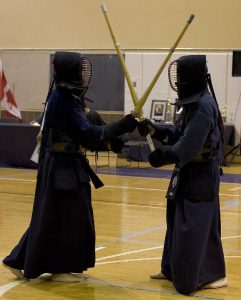The key word in the definition of martial arts is MARTIAL. Martial comes from the word Mars (the Roman God of War) and means warrior-like or related to war. Therefore, martial arts can be defined as the art of being a warrior. Martial arts training develops the physical and mental aspects of being a warrior (whether to defend against dangers in the civilian world or in the military/law enforcement professions).
A more technical martial arts definition is unarmed and/or weapons-based combat training for self-defense or police/military actions. This training is structured and taught by skilled instructors. Martial arts students learn and constantly practice techniques such as kicks, punches, grappling and/or weapons handling (i.e. wooden Bo staffs). Examples of well-known martial arts are Shotokan Karate, Muay Thai, Krav Maga, Mixed Martial Arts (MMA), Brazilian Jiu-Jitsu (BJJ) and Taekwondo. Nevertheless, there are hundreds of other popular martial arts styles.
Beyond the primary focus on self-defense applications, martial arts training has many other martial arts benefits. Martial arts can help with enhanced physical fitness such as speed, strength and conditioning. It also can improve overall coordination, balance and flexibility. Moreover, martial arts training can help with internal discipline and mental toughness. In turn, these benefits help martial arts students to more successful manage “martial” situations because the training often makes them stronger, faster and better able to mentally and physically handle dangerous and stressful situations.
Martial arts were created thousands of years ago in order to defend communities against invaders and to protect individuals from bandits. Weapons-based martial arts based on swords and spears were created very early in man’s history and were practiced by most nations and groups. Experts think that structured unarmed combat styles with large student bases were developed later. Nevertheless, many martial arts styles were developed thousands of years ago. Examples of ancient unarmed martial arts styles include Boxing (multiple countries), Pankration (Greece) and Shaolin Kung Fu (China). Some martial arts definitions state that martial arts are “mainly of Japanese origin”. However, that is not true. Martial arts styles have been created in a wide variety of countries and regions such as China, India, Israel, Brazil, Africa, Europe, Korea… and of course Japan.
In recent years, some martial arts schools have partially or fully morphed into mediation centers, exercise studios, children’s activity zones, etc. Even instructional elements that might seem unrelated to self-defense applications such as Karate kata or point-based “sports” sparring competitions are martial arts methods to teach self-defense. Kata allows students to practice martial arts techniques (i.e. kicks, punches and blocks) without a partner. In addition, point-based sparring enables students to practice against a moving and unpredictable partner. However, most martial arts schools remain dedicated to teaching self-defense techniques to their students. The vast majority of martial arts styles in the modern era remain true to the martial arts definition of teaching students the art of being a warrior.
Martial Arts Definition & History of Martial Arts
Martial Arts Definition – True Meaning of Karate
Weapon-Based Martial Arts

Image provided bu Wikimedia Commons
Reference Sources
- Ancient History Encyclopedia, Pankration, https://www.ancient.eu/pankration/
- The Telegraph, A Brief History of Shaolin Temple, https://www.telegraph.co.uk/china-watch/culture/highs-and-lows-of-a-storied-past/
- Wikipedia, Martial Arts, https://en.wikipedia.org/wiki/Martial_arts